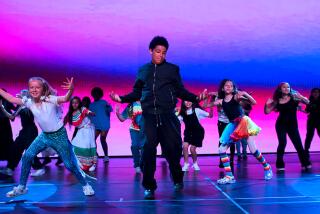Getting Back Into the Swing of Things : With the step surging in popularity, champions Jamie and Gail Arias have begun teaching classes in Thousand Oaks.
Swing’s the thing! So gals, get out those short flirty skirts and don’t forget the bicycle pants. You’ll find more swingers vying with line dancers for center space on the dance floor.
If the couple hops around, they’re dancing the Lindy. When the guy stays planted and the woman dances back and forth, they’re West Coast Swingers. But two-steppers, as you circle the floor, watch out for enthusiastic couples doin’ East Coast Swing.
That’s when a cowboy seems to swing his partner around, lariat-style. Or he’ll upend the gal without her losing lunch. But all those flyin’ bodies and elbows could break a nose. So some folks are learning West Coast Swing in self-defense.
And this growing interest has created a demand for workshops.
Luckily, Jamie and Gail Arias, the California State West Coast Swing champions, recently moved to Thousand Oaks where they teach at the new Borderline Bar and Grill.
When I talked to them, the couple had just returned from the 11th U. S.-International Open Swing Dance Championship, held each Thanksgiving weekend at the Disneyland Hotel. It is the biggest and most well-attended swing dance championship in the world, with hundreds of participants, according to Gail Arias.
In a recent interview, the Ariases discussed the state of the art of swing dance:
How did you do in this year’s competition?
Gail: We are No. 1 in California and the Southwestern region of the U. S. in the most advanced division--the showcase swing division--of West Coast Swing. And this year we placed second in the world. We were beaten by just one-10th of a point. We do Lindy, West or East Coast swing, or any form of swing with lifts off the ground called aerials.
Why do you think people are so eager to learn West Coast Swing?
Gail: It’s been featured in films like “The Swing Kids,” “Malcolm X” and “A League of (Their) Own.”
Jamie: Also, the two-step is very easy to learn. But most people get bored with two-step. And the amount of variations in a line dance are limited. But once people get a taste of swing and R & B music, they want more.
Gail: I find it more sophisticated than other types of swing. There are hundreds of steps and syncopations. And the lead and follow is endless with swing. East Coast swing doesn’t look as cool, as sophisticated. And it doesn’t fit as well to do East Coast Swing to R&B; music. That’s why the music dictates the dance--the dance doesn’t dictate the music.
What about the music?
Jamie: There is a lot of new music suitable for swing. Most of the top country tunes are swing tunes. Since these numbers are the favorite tunes, they are being used to choreograph line dances. But people don’t realize it is the swing music that is turning them on.
Is it true that West Coast Swing is more difficult to learn than East Coast?
Gail: It does take more commitment. It’s not something you can learn in a club in one dance lesson. The best way to learn West Coast Swing is to take a course where everyone is starting at the same level.
I noticed you talk a lot about music in your classes. For example, it was helpful to think of a slow two-step as one, two, three-and-four, five-and-six.
Gail: Yes. Our goal is to make students sensitive to the rhythm or “phrasing” of the music. It’s not just about steps. Music is music. And you’re either dancing on or off the beat. The concept is nothing new. Skippy Blair developed the Unit System about 20 to 25 years ago. She has created a common vocabulary for all dance teachers to have an effective way to interpret and communicate it.
Can you explain the origin of all these swing-type dances?
Gail: All the swing dances are derivations of one another. Swing was born in the 1920s with the Charleston, which was done side by side--not holding hands. But it evolved into a couples dance.
Jamie: A lot of couples dances evolved that way. But the Charleston was really a line dance.
Gail: West Coast Swing was born in the late 1930s when the film industry wanted to fit as many people as possible on a sound stage. That’s where you get the idea of slotting the dancer. The Shag and Lindy Hop also were created in the 1930s. Next came jitterbug--later called the be-bop--in the late ‘40s through the mid-’50s. In the 1950s you see the poodle skirt. And the dance was very physical, very flirty, where the guy threw the girl around. With the popularity of the Beatles in the 1960s, couples dances went out.
Jamie: But swingers never stopped. They just went underground to little clubs until John Travolta and the hustle craze of the ‘70s brought back partner dancing. But only a few people could make it look good. And there weren’t enough good teachers. That’s why it died out quickly. Then during the first country craze of “Urban Cowboy” in the early ‘80s, everybody got hooked on swing.
NEXT WEEK
Get the run-down on New Year’s Eve events for fans of country, and find out where to get swing lessons.
Details
* WHAT: West Coast Swing Night
* WHEN: Mondays, half-hour lessons at 7 and 8 p.m. Dancing at 8:30 p.m., open to all levels; DJ plays about 80% swing music
* WHERE: Borderline Bar and Grill, 99 Rolling Oaks Drive, Thousand Oaks, 446-4435
* COST: $3 cover
* FYI: The Ariases also offer classes and workshops in swing and other social dances at the California Dance Theatre, 5863 Kanan Road, Agoura Hills, (310) 535-5969 or (805) 494-6418.
More to Read
Go beyond the scoreboard
Get the latest on L.A.'s teams in the daily Sports Report newsletter.
You may occasionally receive promotional content from the Los Angeles Times.










